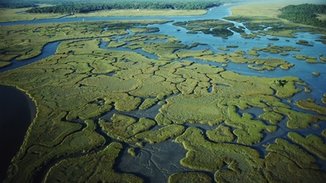Using insurance industry models, researchers determined that wetlands prevented some $625 million in damages due to Hurricane Sandy. Christopher Intagliata reports.
研究者用保险业模型计算后发现,湿地在桑迪飓风中为城市提供的保护相当于六亿两千五百万美元。
撰文/播音 Christopher Intagliata克里斯托弗·因塔利亚塔
翻译 张清越
审校 郭晓
As Houston begins recovery efforts from Hurricane Harvey, a new storm threat—Hurricane Irma—is barreling west towards the Caribbean and Florida. We have few defenses against hurricanes' lashing rains and wind and storm surge—but nature does provide one.
当休斯顿刚从哈维飓风的冲击中恢复过来时,新的风暴危机——飓风伊玛——又朝着西边的加勒比海和佛罗里达滚滚而来了。面对飓风带来的的狂风暴雨,人类的防御措施屈指可数——但大自然却为我们提供了一种天然屏障。
"Wetlands act in two ways to reduce the impacts of storms. They reduce storm surge by acting as a wall or a barrier and they act as a sponge by soaking up the waters that come down via rainfall."
“湿地可以从两个不同的方面减弱风暴带来的的影响。它们不仅能像墙或屏障一样抵挡风暴的直接冲击,还能像海绵一样吸收随之而来的降雨。”
Michael Beck is a coastal scientist at The Nature Conservancy and the University of California Santa Cruz. He says as we've paved over swampy coastlines, we've changed how storm waters flow. Or, for an analogy a little closer to home:
迈克尔·贝克(Michael Beck)是美国大自然保护协会和加利福尼亚大学圣克鲁兹分校的一名海岸科学家。他说当我们填铺湿地海岸线的同时,我们也改变了风暴中雨水的流向。让我们来打个更贴近生活的比方:
"Rain falls on your driveway, it's going to run straight out into the street. Rain falls in your garden it's going to soak into the ground. When you've done that at the scale of whole watersheds, there's nowhere for that water to go when it rains.”
“当雨水落在你的私人车道上时,它会直接流到马路上。可当雨水落在你的花园里时,它却会被吸进土壤里。如果你把这种防护措施放大到整个流域的尺度,雨水将变得无处可逃。”
But some wetlands do remain. Beck and his colleagues teamed up with the insurance industry, and, using the industry's risk assessment models, asked: how much more damage would Hurricane Sandy have delivered if all the eastern seaboard's wetlands were gone? And they found that marshy coastlines saved some $625 million dollars in direct flood damages—or about one percent of Sandy's total cost.
有些湿地的确被保存了下来。贝克和他的同事们与保险行业合作,用行业里的风险评估模型计算了这样一个问题:如果东海岸线的所有湿地都消失了,桑迪飓风还会带来多少额外的损失?他们发现,湿软的沼泽海岸线在洪水冲击中直接帮助人们避免了六亿两千五百万美元的损失,而这也是桑迪飓风造成损失总额的百分之一。
The researchers also battered Ocean County, New Jersey, with thousands of hypothetical storms using flood models. And found that wetlands cut flood damages there by 16 percent, compared to areas of the county where wetlands are gone. The study is in the journal Scientific Reports. [Siddharth Narayan et al., The Value of Coastal Wetlands for Flood Damage Reduction in the Northeastern USA]
研究者们还利用洪水模型模拟了数千场暴风雨,来打击新泽西海洋县。相比县里没有湿地的区域,有湿地的地方洪水带来的损害减少了16%。这篇研究发表在了《科学报告》(Scientific Reports)上。
Next, it's up to local governments and the insurance industry to take notice. "Certainly we hope that we will continue to conserve wetlands in part for their intrinsic beauty and the importance of nature." But he says by putting a price-tag on the economic benefit of wetlands it might change the conversation…about conservation.
接下来,地方政府和保险业就该注意了。“我们当然希望大家能继续保护湿地,部分原因是由于湿地原生态的美及其对自然的重要性。” 但他表示,当考虑到湿地的经济利益时,保护问题也许又将变得迥然不同。
—Christopher Intagliata

 京公网安备11010502039775号
京公网安备11010502039775号  京公网安备11010502039775号
京公网安备11010502039775号 
















